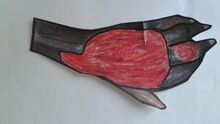Atypical mycobacterias
These are mycobacteria that are primarily/occasionally pathogenic to saprophytic.
Acid-resistant, immobile, non-sporulating aerobic rods.
They cause diseases that are analogous to tuberculosis = mycobacteriosis.
They occur in between 3-7% - in water, soil (the usual source of infection). Transmission between humans does not occur.

Representatives[edit | edit source]
Due to the large number of representatives of mycobacteria, we list only the most important ones.
- Mycobacterium kansasii
- Mycobacterium gordonae
- Mycobacterium xenopi
- Mycobacterium avium
- Mycobacterium intracellulare
- Mycobacterium scrofulaceum
- Mycobacterium ulcerans
Atypical mycobacteria grow at temperatures between 38 and 42 °C.
Classification of mycobacteria[edit | edit source]
Classification according to Runyon[edit | edit source]
- Photochromogenic - mycobacteria are non-pigmented in the dark, when illuminated they have a yellow colour (e.g. Mycobacterium kansasii).
- Scotochromogenic - mycobacteria are orange or yellow pigmented even in darkness (e.g. Mycobacterium gordonae).
- Nonchromogenic - mycobacteria are not pigmented (e.g. Mycobacterium avium).
- Fast-growing - mycobacteria with rapid growth within a maximum of 5 days[1] (e.g. Mycobacterium fortuitum, Mycobacterium chelonae).
Clinically important representatives[edit | edit source]
- Complex MAI/MAIS
Mycobacterium avium + Mycobacterium intracellulare = (complex MAI); + Mycobacterium scrofulaceum = (complex MAIS)
Occurrence mainly in birds and pigs. In humans, they cause cervical lymphadenitis and tuberculosis-like lung disease. When they penetrate tissues, they can cause leprosy-like diseases.
- Mycobacterium xenopi
- Mycobacterium ulcerans
It causes a so-called Buruli ulcer, which is a painless nodular formation that develops into an extensive skin lesion.
- Mycobacterium kansasii
A relatively common causative agent of disease, it causes chronic lung disease mimicking tuberculosis.
Diagnosis[edit | edit source]
Diagnosis of mycobacterial diseases is based on the overall assessment of symptoms, X-ray findings, isolation and identification of mycobacteria. The clinical symptoms of mycobacteriosis are very similar to those of tuberculosis and without species specification of the causative agent, the disease cannot be differentiated.
Significant symptoms:
- general weakness;
- cough;
- shortness of breath;
- loss of apetite;
- weight loss úbytek;
- increased temperature;
- sweating.
In children, the orofacial region is often affected. In adult patients, nodal involvement is rare (mainly immunocompromised patients and patients with HIV infection). Sometimes the skin, bones, soft tissues, digestive tract, liver and spleen are affected.
To identify mycobacteria, we perform microscopic and culture examinations. Positive culture findings may correspond to infection, asymptomatic colonization or just contamination from the external environment.
At least two culture-positive findings from separate sputum examinations or at least one culture-positive finding obtained by bronchial lavage or lavage are required together with clinical and radiological findings. The diagnosis may also be established by transbronchial or other lung biopsy with evidence of granulomatous inflammation or acid-fast bacilli, accompanied by at least one positive sputum culture or bronchial lavage for non-tuberculous mycobacteria.
If we suspect atypical mycobacteria and all basic diagnostic criteria are not met, it is necessary to further monitor the patient clinically, radiographically and microbially.
The basis and gold standard of laboratory testing is the cultivation of mycobacteria on liquid and solid media followed by species identification of the strain. The molecular genetic technique, based on the detection of microbial DNA, is a highly sensitive and rapid method that can be used in the diagnosis of M. kansasii, M. gordonae. BACTEC or biochemical tests (e.g. with niacin) distinguish between tuberculous and non-tuberculous mycobacteria.
Cultivation[edit | edit source]
Slow growth on special soils. On firm soils (Lowenstein-Jensen, Ogawa) it grows in bulky smooth grey-white colonies. In liquid soils (Šula's soil) we observe amorphous sediment with milky turbidity.
During cultivation, we evaluate:
- cultivation rate;
- colony size;
- the appearance of the coloniesí;
- pigmentation;
- enzyme production.
Staining[edit | edit source]
Due to the high lipid content in the body of mycobacteria, Gram staining is not possible. Therefore, we use Ziehl-Neelsen staining.
Treatment[edit | edit source]
Treatment of mycobacterioses is difficult (except for M. kansasii). The effect of treatment is often very slow, caverns and sputum culture positives may persist for a long time. Treatment is often initiated with classical antituberculosis drugs, in combination with HRES (isoniazid, rifampicin, ethambutol, streptomycin), and only then is the treatment adjusted according to the sensitivity found.
There is no single treatment regimen for mycobacterial diseases. Different combinations of antituberculosis drugs are used.
The vast majority are resistant to a number of antituberculosis drugs.
Links[edit | edit source]
Related articles[edit | edit source]
References[edit | edit source]
- ↑ JULÁK, Jaroslav. Úvod do lékařské bakteriologie. 2. edition. 2015. 0 pp. ISBN 978-80-246-3210-0.
Bibliography[edit | edit source]
- BEDNÁŘ, Marek. Lékařská mikrobiologie: bakteriologie, virologie, parazitologie. 1.. edition. Praha : Marvil, 1996. ISBN 80-2380-297-6.
- VOTAVA, Miroslav. Lékařská mikrobiologie obecná. 2.. edition. Brno : Neptun, 2005. ISBN 8086850005.
- VOTAVA, Miroslav. Lékařská mikrobiologie speciální. 2.. edition. Brno : Neptun, 2006. ISBN 8090289665.
- JULÁK, Jaroslav a PAVLÍK Emil. Lékařská mikrobiologie pro zubní lékařství. 1.. edition. Praha : Karolinum, 2010. ISBN 9788024617923.


